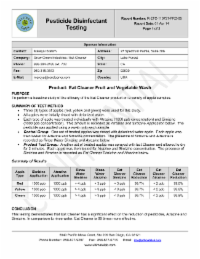
For several commodity groups, the violation rate was higher for import samples. 7.9% of the import fruit samples were violative compared with 1.8% of the domestic fruit samples; and 12.5% of import vegetable samples were violative, whereas 9.4% of domestic samples were violative. Yet, within specific categories, there are some real offenders where almost half of the samples were in violation of the limits.
EP 35: Breaking Down Pesticides and How to Avoid Them. LISTEN TO THE FULL EPISODE HERE The violation rate for domestic samples was slightly higher in FY 2017 than in recent years, largely due to the increase in use of pesticides on leafy greens.
Probably the most concerning of all is, there are a fork ton of pesticides being used in our food production. FDA pesticide methods could detect 761 pesticides and industrial chemicals. Of these chemicals, residues of 221 different pesticides were actually found in the samples analyzed, including DDT which has been banned for use in the US since 1972.
Many of these produce items have multiple residues and while they may not individually be over the legal limits, the 'cocktail' effect of these pesticides can be deeply concerning according to Dr. Shawki Ibrahim, blogger for 5G Aktien and Emeritus Professor, Environmental Health Sciences.
And of the produce items we eat, there is an increased violation rate of the vegetable commodities group resulting from leafy vegetables such as cilantro (48.3%), kale (25.8%), and leaf lettuce (14.8 %) that were targeted for increased sampling. To break that down, almost half of the cilantro, over a quarter of kale and almost 15% of leaf lettuce that is sold to consumers is over the pesticide limits. There are several produce commodities over the 20% mark, which raises a huge red flag to us.

Top 3 pesticides found:
Imidacloprid (470)
Boscalid (438)
Azoxystrobin (348)
Carbendazim° (299)
Now, for specifics on how many samples collected were in violation, check out the numbers below for both domestic and imported produce items. Items particularly concerning where over 10% of the samples are 'in violation' are in red. You'll note there's a lot of red in the imported section.

Violative Domestic samples
Blackberries - 6.9%
Oranges - 4.5%
Plums - 9.7%
Strawberries - 2.6%
Celery - 6.7%
Cilantro- 48.3%
Collards - 100%
Kale - 25.8%
Leaf lettuce - 14.8%
Okra - 25%
Green, Snow, Sugar and Sweet Peas - 9.1%
Radish - 3.4%
Spinach - 18.2%
Squash - 7.9%
String Beans - 17.9%
Sweet potatoes - 3.8%
Violative Foreign samples
Apricots - 13%
Blackberries - 9.4%
Cherries - 7.7%
Dates - 14.9%
Figs- 23.5%
Grapes - 11.4%
Grapefruit - 14.3%
Lemons - 5.9%
Limes - 7.3%
Mangoes - 8.9%
Nectarines - 4.2%
Oranges - 6.2%
Papayas - 14.3%
Peaches - 3.6%
Pineapples - 17.5%
Plums - 5.3%
Asparagus - 4.3%
Bok Choy - 33.3%
Broccoli - 4.9%
Carrots - 20.7%
Celery - 38.5%
Cilantro - 37.3%
Cucumbers - 9.1%
Eggplant - 16.1%
Ginger - 23.5%
Kale - 8.2%
Head Lettuce - 14.3%
Leaf Lettuce - 12.9%
Mushrooms - 8.9%
Okra - 14.3%
Onions/leeks/scallions/shallots - 10.7%
Peas - 16.9%
Hot peppers - 23.4%
Radish - 28.6%
Spinach - 23.1%
String Beans- 15.6%
Turnips - 8.3%
To help protect your plate, we recommend you:- Remove the outer leaves of leafy greens, and peel produce where pesticides can be most concentrated
- Opt for organic produce when available and affordable to avoid chemical pesticide consumption; however, know that both synthetic and organic biopesticides have potential health and environmental effects.
- Clean your produce thoroughly. Most produce is ‘hydrophobic,’ meaning water will just bead up on the surface. eatCleaner® Fruit + Veggie Wash is a way to break the surface tension of fruit and veggies and clean what water can’t. The product is patented, lab proven and comes in a liquid spray, 2x concentrate and wash powder, and is lab proven to remove over 95% of harmful pesticide residue, even from porous strawberries, which are at the top of the EWG’s ‘Dirty Dozen’ list. This is important even if you are using organic produce.
- Grow your own produce. Even if you have just a windowsill garden, growing some herbs can go a long way.
Although processes may be in place to help keep our food supply safer, we are all the last line of defense for our families. Before you enjoy that kale salad, salsa or lettuce wrap, consider cleaning your produce with eatCleaner Triple Action Fruit + Vegetable Wash. Third party lab tests showed eatCleaner was over 95% effective in removing harmful pesticide residues from even porous fruit like strawberries and over 99.8% effective with firm fleshed produce like apples. You can spray, wipe or soak your produce with our eatCleaner products, which will also help extend the freshness of your fruit and veggies up to 5 times longer. Check out the lab studies below, and a link to the full 2017 Pesticide Monitoring Report from the FDA .
Download the full FDA report Download the 3rd party pesticide lab report on eatCleaner efficacy on strawberries
Download the 3rd party pesticide lab report on eatCleaner efficacy on strawberries  Download the 3rd party pesticide lab report on eatCleaner efficacy on apples
Download the 3rd party pesticide lab report on eatCleaner efficacy on apples 